
Pharaoh ants (often erroneously called "pharaoh ants") are the only species of tropical ants that have managed to expand their range far to the north and south due to the colonization of human habitation. Today, the pharaoh ant has managed to become a real cosmopolitan, spreading to almost all continents of the world and becoming a headache for millions of residents of apartments and houses.
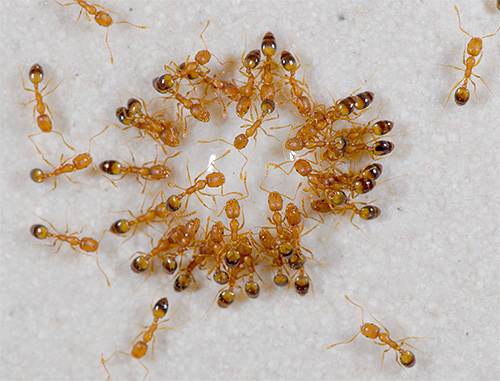
India is considered the historical homeland of the pharaoh ant. Due to its unpretentiousness, small size and some peculiarities of biology, it was this insect that managed to master the ships of seafarers for life, and then the port cities. And already from them, the red-haired conquerors began a victorious march deep into each country into which they accidentally penetrated.
It is interesting
Pharaoh ants got their name due to the fact that they were first caught in the Egyptian pyramids back in the 18th century. Literally immediately after this, the insects were described by Linnaeus, who decided that Egypt was their homeland, and called the ants themselves pharaohs.
Today, most researchers are inclined to believe that the real homeland of pharaoh ants is the territory of Hindustan.
Appearance of pharaoh ants
Pharaoh ants are very small members of their family. Worker ants have a body length of about 1.5-2 mm, the uterus - up to 4 mm, males - about 3 mm.

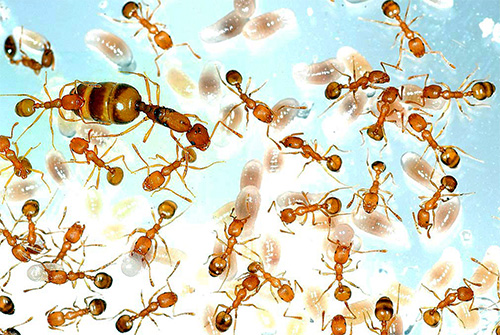
For their characteristic color, pharaoh ants were also called red - the color of the body of a working ant is light brown, almost yellow. The photo shows a worker ant at high magnification.
The pharaoh ant's uterus is darker and similar to the common black garden relatives. The photo shows such a queen surrounded by working individuals:

It is noteworthy that all pharaoh ants have distinct yellow stripes on their abdomens, but due to their small size, they are not particularly noticeable in working individuals.
Eggs and larvae of this species are rarely seen: ants prefer to equip a colony in places where it is difficult for a person to reach. Ant eggs have a diameter of about 0.3 mm, the larvae reach a length of 1-1.5 mm and look like the eggs themselves: as you can see in the photo, they are white, translucent and motionless:

It is the size and color of the body that pharaoh ants differ from other species. In addition, in the conditions of our country, this species cannot exist outside human habitation, and therefore it practically does not occur with its other relatives in one place. So if the ants met in the apartment, and even a whole crowd, they are probably "Indian-Egyptian guests."
Features of the biology of yellow invaders
The main feature of the pharaoh ant is its thermophilicity. Tropical origin affects: this species cannot exist at temperatures below 20 ° C, although in houses and apartments anthills safely survive short-term temperature drops to 10-12 ° C.
This species cannot inhabit outside heated premises on the territory of the entire former CIS. In winter, even mild enough by Russian standards in the southern regions, they simply freeze out.
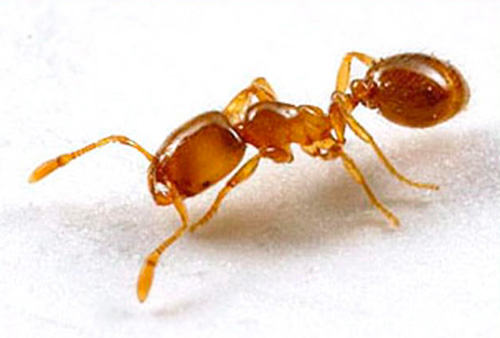
It is interesting
In the conditions of the Russian winter, not a single species of ants can actively live on the soil surface. Domestic species arrange wintering for themselves for half a year, closing in anthills, moving little and rarely eating. Some even take aphids underground to provide them with delicacies. In pharaoh ants, wintering is not provided for in the biological cycle, and they need to be warm and close to food all year round.
Like all ants, the pharaoh ant is omnivorous: any crumbs, products of plant and animal origin, rotting organic matter, and other insects are suitable for food.

An anthill of this species has a very interesting structure. As long as it is small, the entire nest can fit a few square centimeters under a floor covering or among books. When the anthill grows, parts can bud off from it with the creation of additional nests in separate places of the dwelling, but at the same time the connection of the “branches” themselves is maintained, and ants from different nests do not quarrel with each other.
It is interesting
The first ants in Europe appeared in the ports of London and settled under the fireplace stoves in fairly wealthy houses.
But the main feature that pharaoh ants possess is the tolerance of queens to each other. Several tens or even hundreds of breeding females can live together in one colony. Of course, the destruction of one nest from such a super anthill has little effect on the vital activity of others.
Pharaoh ants in the apartment
Ants-pharaohs in the apartment feel even more comfortable than its true owners. They can establish their nests almost anywhere, constantly forge new trails to food sources and expand their settlements.

In their distribution throughout the premises, pharaoh ants are limited only by the available food supplies. They easily penetrate into neighboring apartments and can perfectly live and breed under the parquet of a living room, and feed from a garbage chute.
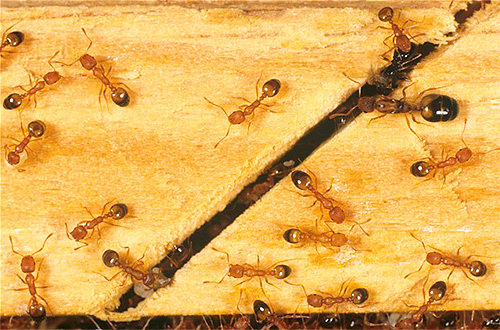
At the same time, the nests of pharaoh ants can be located almost anywhere. These can be cavities behind skirting boards or under furniture, cracks in floors, piles of things in pantries, folds of clothes, boxes of discs - anywhere where a normal temperature is maintained and where a person does not often look.
The most noticeable in the apartment are forager ants, which run along the paths laid and marked by them in search of or when transporting food. When you see them, don't try to destroy them right away. It is much more reasonable to follow their movement and calculate the location of the nest. There pests will be easier to destroy.
How to Get Rid of Pharaoh Ants
Getting rid of pharaoh ants in an apartment is very difficult. Their huge anthill-metropolis can be located in several apartments and house premises. The sources of provisions for them can serve as stocks in residential premises, and dirt in the garbage chute, and in the summer - organic matter from the street. It is precisely because of this that insects do not particularly suffer from the destruction of one or more nests: colonizers from the survivors quickly master the liberated territories and restore their numbers.
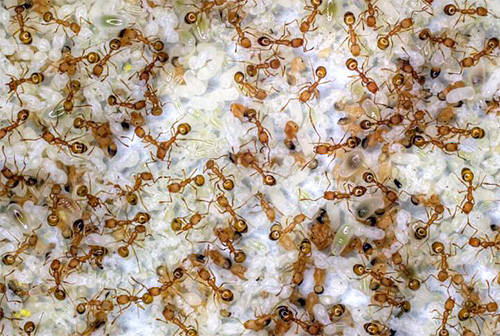
The simplest case is when the anthill is just beginning to develop, and the insects have not yet had time to organize child nests. If you find such a colony and simply vacuum it, the fight against ants can be considered over.
If the ants have been living in the house for a long time, it is best to entrust their removal to specialists from special pest control services. At the same time, the fight against insects must be carried out by the joint efforts of all residents of the house. Those neighbors who do not support the initiative will provide the ants with a chance to survive in their apartments.
You can get rid of pharaoh ants on your own using several types of tools:
- Aerosols - they diligently spray all surfaces in the apartment, and especially - the places of the most frequent movement of insects. If the aerosol gets into the nest, the ants are guaranteed to die. If the nest is located outside the spray zone, then only those worker ants that fall under spraying will die out.
- Gels are effective baits containing powerful insecticides. The beauty of them is that forager ants carry droplets of gels to the nest, where they will poison their other brethren, including the uterus. The action of the gels is extended over time, but with systematic work it gives a very good result.
- Insecticide dusts and crayons. These funds simply fall on the paws of ants, and when insects try to cleanse themselves of them, they are poisoned. Of course, on the paws, the poison can also penetrate the colony of pests.
- Proven folk remedies - borax, boric acid, yeast, cornmeal. These substances are poisonous to ants and can be used to make effective poison baits.
Other means - repellent herbs, sticky traps - either scare away ants for a while without destroying them, or exterminate only foragers, without affecting the colony itself. There will be practically no result from their use.
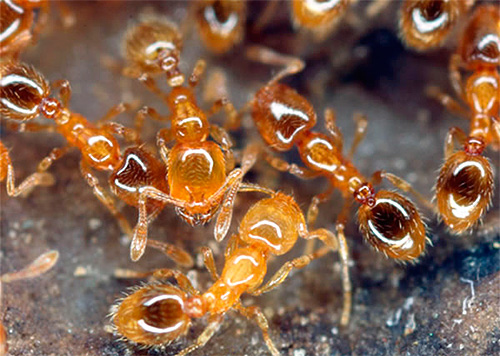
When choosing a remedy for pharaoh ants, one should not consider ultrasonic and magnetic resonance repellers - ants are not afraid of them, and such devices will not help get rid of these insects. Read more about these tools in a separate article on our website.
The best protection against pharaoh ants will be reliable prevention of their appearance in the apartment: maintaining cleanliness, absence of garbage and openly stored food waste, insecticide treatment of insect penetration routes into the house. There are cases when, with proper prevention, the owners of the apartment managed to protect it from ants during the total infection of an entire multi-storey building.

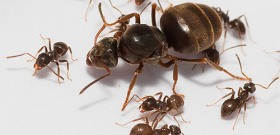


Thanks a lot to the author, it was quite informative to read, I rarely get past a well-written article, thanks again for sharing your experience, good luck and development.
About ten years ago, these red-haired guests came to our apartment. Were mostly in the kitchen and rarely met on the floor in the toilet. She started the fight right away, which is probably why she got rid of them without any problems. 1. All bulk products into jars; 2. Stored bread and cookies in the refrigerator; 3. Garbage bag kept constantly tied; 4. All the furniture on the back side was outlined with a special pencil (I don’t remember the name, like Masha); 4. Not a single crumb left on the table and floor; 5. I wiped water, if possible, from all surfaces, a sink, a table, etc. (I read somewhere at that time that they definitely need water). They didn't return again. Order and cleanliness is the key to quick deliverance. I wish you all good luck in the fight!
I can't eat bread
Free hack. We have these parasites lived for about 10 years, it was not possible to remove them. Killed dozens of them every day. But one day something changed - there were fewer ants, and then they completely disappeared, and this has been going on for more than a year. Not a single ant. The recipe is simple - a silverfish settled in our apartment, or something similar. I've seen her twice in all that time. Apparently, she devoured all the ants. She looks ugly, but it's better than a horde of ants.
These ants tormented. Go back to your India, redheaded creatures.
Hello! For more than 2 years I can’t get the bugs out in any way, all the chemistry acts on them only upon contact, and if he sat behind the plinth and didn’t hit him, then all the disinfection is useless ... In this regard, the question is: is it worth bringing red ants from the dacha ? They will eat all the bugs, and then I will breed the ants?
Yeah, and then burn the apartment down with the ants.